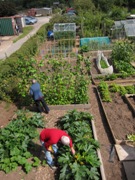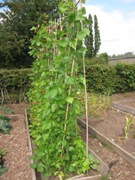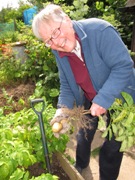Last week we visited a family garden in Manchester—this week we will visit a family garden in Coventry—in the Midlands of England.
Chris Francis’ allotment at the Beachwood/Earlsdon Allotments are near the center of Coventry. Chris was kind enough to give me a tour of her allotment that she has had for 3 years. Chris and a friend share a ½ allotment (10m x 15m) for which they pay $24/year—or $2 per month
Crop List:
Cauliflower
Purple sprouting broccoli
Swiss Chard
Carrots
Leeks
Zucchini (courgettes)—3 types
Potatoes (5 types including Earlies: Maris Piper and Lady Balfour)
Runner Beans
Peas
Gooseberries
Onions
Spinach
Sweet Corn
Garlic
Apple Trees
Pear Trees
Rhubarb
Herb Garden
Challenges:
Two of their biggest challenges are white cabbage white butterfly (she covers the brasssica beds with netting), carrot root fly (she surrounds the carrot bed with a 24” highs wall of fine mesh; this is effective as the carrot root fly flies close to the ground), and slugs.
Soil & Water
Chris double digs her raised beds and liberally applies compost which she makes onsite, and also uses chicken manure and bone meal. She does not use insecticides nor chemical fertilizers.
In an effort to conserve water, the allotment association doesn’t allow watering with hoses; gardeners are required to use watering cans.
All and all, Chris’ garden is bountiful and I was able to enjoy several wonder meals made from her garden harvest which included potatoes, zucchini peas, salad and a classic English dessert–gooseberry crumble.
Learn how to develop a community centered, impact oriented project.




